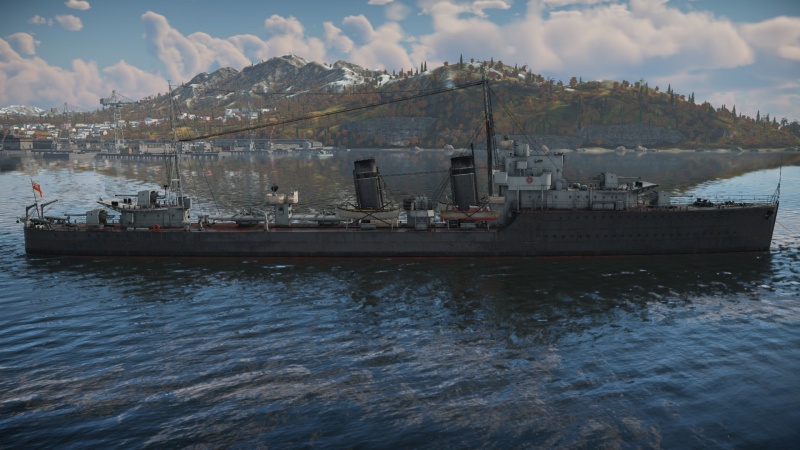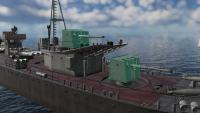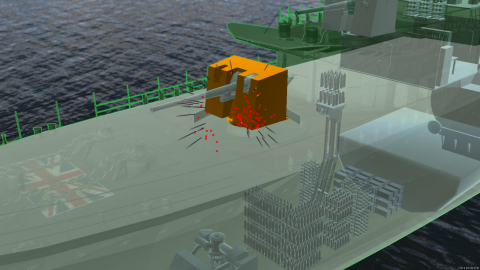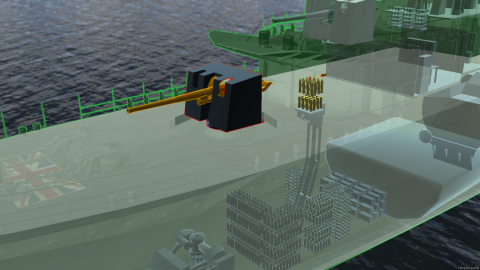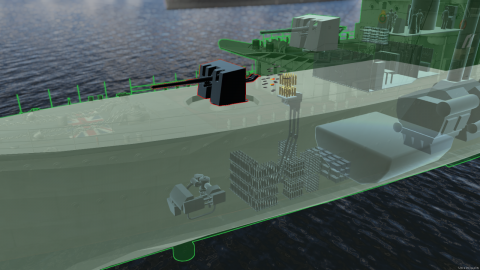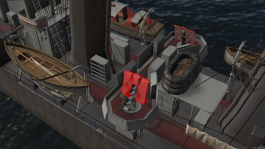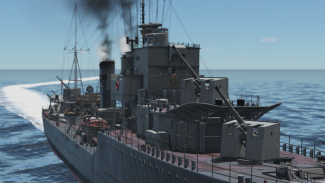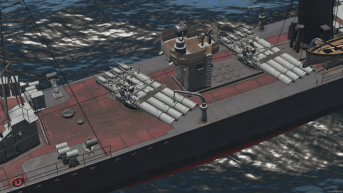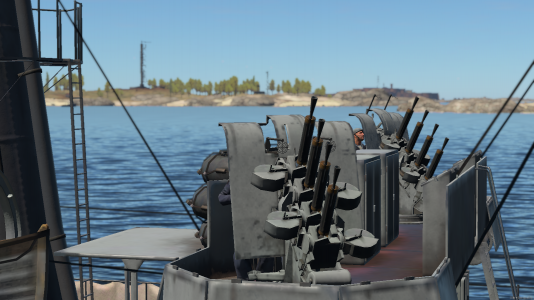HMS Grafton
Contents
Description
The HMS Grafton (H89) is a member of the G-class destroyer family. She was constructed in the mid-1930s, when the HMS Grafton was stationed in Spanish waters from 1936 to 1939 to enforce the non-interventionist agreements reached by Britain and France during the Spanish Civil War. She was transferred from the Mediterranean Fleet to the UK for escort and contraband inspection duties after World War II began. When the Norwegian Campaign started in April 1940, the HMS Grafton was undergoing refit; after the work was finished, the HMS Grafton escorted convoys to Norway. In May, she rescued British troops from the bridgehead of Dunkirk; however, a German submarine sank her after she stopped to recover survivors from a destroyer.
Introduced in Update 1.83 "Masters of the Sea", the HMS Grafton is equipped with heavy firepower for her size. However, she remains extremely vulnerable to most enemy destroyers. The HMS Grafton is most useful when employed as a quick-light support destroyer, evading enemy fire with its superior mobility. The HMS Grafton may be able to survive confrontation with other enemy destroyers thanks to her powerful main armament, but she will almost definitely come out of it severely damaged. Therefore, the best chances are to move or hide deep behind the enemy, attack first, and maintain the distance.
General info
HMS Grafton performs excellently in the destroyer vs. destroyer area, thanks to her 4 x 120 mm 4.7 inch/45 Mk.XII main guns. Her mobility is also remarkable, but the less appealing aspects are her lacklustre anti-air defences and the yet below-average crew size. The ship surely stands out from the other low-rank destroyers because of her entirely dark-grey hull, with a maroon red deck. Although, she can be found using the completely different camouflage scheme of HMS bulldog (under the different pennant number H91) in western approaches' white tone. The ship features a completely raked bow and a hull with a lot of freeboard, similar to the Tribal-class hull. Another way to differentiate her from other destroyers, is her four single turrets, two at the bow and two located in the stern.
Notice the anti-air fire is expected to be low, mainly Vickers Mk.V (12.7 mm) turrets. A double set of quadruple torpedo mountings can be seen just abaft her two inclined funnels.
Survivability and armour
The crew size is an essential indicator of survivability amongst destroyers but HMS Grafton does not offer any significative advantage over other Rank I destroyers, with her crew being only of 145. Captains must be prudent in their combat actions to preserve the life of their complement.
The armour present on HMS is limited to gun shielding and turret protections consisting of:
- 12.7 mm of antifragmentation armour
- 4.97 mm of antifragmentation armour
HMS Grafton's hull is made of 16 mm of steel while the superstructure is protected by 10 mm of steel.
This armour won't provide significant protection against most of the destroyer's main calibre shells (100+ mm). The hull armour is only practical against 12.7 mm or less. Any HE shell impact to the hull, will cause the total loss of crew in that compartment. Usually, shells with more than 2 kg of explosive mass.
The superstructure can protect against low calibre machine guns but any aircraft with automatic cannons like the Soviet IL-2s or the German Ju 87s will pierce the superstructure of the ship. Increasing the risk of an ammo rack detonation because of the aircraft's strafing rounds. This packed with the poor anti-air defences is not a good deed for survivability; be observant.
Ammo racks
On the bow section, is present an unsafe spot for the Grafton: the ammo racks. This area is filled with ready ammo racks near both turrets and just beneath it, a big stash of ammunition is located. This ammo storage is unprotected by any fuel tank or armour and is located above the waterline. Enemy ships will often target this zone with AP or HE with base fuse, because of how easy it is to hit it and detonate the main ammo rack.
APCBC shells found on destroyers such as those on the Italian bluewater ships at rank I, can cause catastrophic damage to the ammo rack with some precise shooting. The elevator for the ammo can also be damaged during combat, hindering the reload rate of the main guns.
The numerous torpedoes inside the torpedo tubes are actually well protected against HE and shrapnel. It is unlikely they will generate any harm for the Grafton- Only a very well placed SAP or AP shot might detonate them.
Mobility
HMS Grafton offers a very low top speed compared to the other destroyers of its rank, but an excellent turn rate, allowing it to easily avoid torpedoes even without Rudder Replacement modification.
Mobility plays an important role in the playstyle of the Grafton. Because of the poor targeting speed of the main cannons, the H89 will need to often steer to help the turrets get on target. Captains must be clever to fire first using the mobility in their odds. With the torpedoes, something similar happens. The H89 needs to steer quite a lot to allow the release of torpedoes.
Performing evasive manoeuvres against planes or torpedoes shouldn't be much trouble for the agile Grafton.
| Mobility Characteristics | |||||
|---|---|---|---|---|---|
| Game Mode | Upgrade Status | Maximum Speed (km/h) | Turn Time (s) | Turn Radius (m) | |
| Forward | Reverse | ||||
| AB | Stock | 55 | 16 | ~89.98 | ~153.16 |
| Upgraded | ___ | ___ | |||
| RB/SB | |||||
| Upgraded | ___ | ___ | |||
Modifications and economy
"Tool set" and "Fire protection equipment should be immediately acquired. After this, "smoke screen" and mobility modules can be researched over the firepower.
Armament
Primary armament
HMS Grafton is armed with 4 x turrets of 4.7 inch/45 Mk.XII (120 mm) guns.
These guns were used widely by destroyers during WWII. It is worth familiarizing yourself with the ballistics and the damage mechanics. They are remarkably adequate in terms of damage. The gun's explosive mass of 3 kg of TNT is excellent, a new taste of firepower potential when compared with the unavailing 721 g of TNT in the Town-class. The fire rate is very good, 12 rounds/min. Once the ready-ammo rack is used, the fire rate is reduced to a still very useful 10 rounds/min.
Now, any small boat will often sink into hull break due to the strong blast force. It is actually possible to dispose of a small patrol boat with a single shot per turret. Hence 4 patrol boats can be destroyed in quick succession by the 4 main cannons due to the rapid-fire and the powerful explosive mass. They also hold the ability of dual-purpose guns, this expands the value against not only naval threats but aerial threats.
The guns provide reasonable elevation angles (40°), which are not 90° but achieve the purpose of fighting against enemy aircraft. It was deemed acceptable during WWII since the intention was to engage an enemy aircraft attacking another member of the fleet, the destroyers acting as an anti-air screen for the battlefleet during air raids.
The trouble of the armament is about the mounting itself, the CPXVII. These turret mountings are really slow on the horizontal traverse, only 7.0°/s. This difficult slow traverse is very noticeable if the ship is halted. It affects the ability to quickly retaliate fire to any ship encountered in a new untargeted direction.
Any destroyer with the same level of mobility and with faster turret traverse will have an advantage over HMS Grafton, like the German destroyers Z15 Erich Steinbrinck or T22.
| Penetration statistics | |||||||
|---|---|---|---|---|---|---|---|
| Ammunition | Type of warhead |
Penetration @ 0° Angle of Attack (mm) | |||||
| 1,000 m | 2,500 m | 5,000 m | 7,500 m | 10,000 m | 15,000 m | ||
| HE Mk.VIIA | HE | 35 | 35 | 35 | 35 | 35 | 35 |
| SAP Mk.VA | SAP | 116 | 92 | 63 | 44 | 33 | 29 |
| HE-TF Mk.VIIA | HE-TF | 35 | 35 | 35 | 35 | 35 | 35 |
| HE-VT Mk.VIIA | HE-VT | 35 | 35 | 35 | 35 | 35 | 35 |
| Shell details | ||||||||||||
|---|---|---|---|---|---|---|---|---|---|---|---|---|
| Ammunition | Type of warhead |
Velocity (m/s) |
Projectile mass (kg) |
Fuse delay (s) |
Fuse sensitivity (mm) |
Explosive mass (TNT equivalent) (g) |
Ricochet | |||||
| 0% | 50% | 100% | ||||||||||
| HE Mk.VIIA | HE | 808 | 22.68 | 0 | 0.1 | 3,000 | 79° | 80° | 81° | |||
| SAP Mk.VA | SAP | 808 | 22.68 | 0.015 | 5 | 900 | 47° | 60° | 65° | |||
| HE-TF Mk.VIIA | HE-TF | 808 | 22.68 | 0 | 0.1 | 3,000 | 79° | 80° | 81° | |||
| Proximity-fused shell details | ||||||||||||
|---|---|---|---|---|---|---|---|---|---|---|---|---|
| Ammunition | Type of warhead |
Velocity (m/s) |
Projectile mass (kg) |
Fuse delay (m) |
Fuse sensitivity (mm) |
Arming distance (m) |
Trigger radius (m) |
Explosive mass (TNT equivalent) (g) |
Ricochet | |||
| 0% | 50% | 100% | ||||||||||
| HE-VT Mk.VIIA | HE-VT | 808 | 22.68 | 0 | 0.1 | 244 | 23 | 3,000 | 79° | 80° | 81° | |
Secondary armament
The 12.7 mm Vickers Mk.V turrets are present in HMS Grafton on an anti-air role.
The range in which the AI gunners start to open fire is below 2,000 m. The player must remember this range since the guns will start to open fire often too late to perform manoeuvres against low-level bombers or torpedo attackers.
The Vickers mountings are placed amidships, one in starboard and one in port. They have really good elevations angles of 75° which generally allow them to overlap their range to fire together against a target. The intended purpose of these guns is to provide an obstacle to enemy aviation, but their use is limited to close ranges, often too close. The Vickers also lack the stopping power of autocannons to successfully down all-metal planes. Armoured attackers will also be a significant concern to the heavy machine guns.
The 2 turrets of 4 Vickers Mk.V heavy machine guns offer really good damage against any patrol boat. This is notable on other vehicles such as the MGB-61 in the coastal fleet, that uses the Vickers as the main armament. Grafton can engage any patrol boat with them, however, the 120 mm cannons remain the first choice because of the hull-break capacities.
- Universal: T · AP · I
- 12.7 mm I: T · I · I · I
- 12.7 mm API: T · AP · I · AP
| Penetration statistics | |||||||
|---|---|---|---|---|---|---|---|
| Ammunition | Penetration @ 0° Angle of Attack (mm) | ||||||
| 10 m | 100 m | 500 m | 1,000 m | 1,500 m | 2,000 m | ||
| T | 20 | 19 | 16 | 13 | 10 | 8 | |
| AP | 24 | 24 | 20 | 17 | 14 | 12 | |
| I | 3 | 2 | 2 | 2 | 2 | 2 | |
| Shell details | ||||||||||||
|---|---|---|---|---|---|---|---|---|---|---|---|---|
| Ammunition | Velocity (m/s) |
Projectile mass (kg) |
Fuse delay (m) |
Fuse sensitivity (mm) |
Explosive mass (TNT equivalent) (g) |
Ricochet | ||||||
| 0% | 50% | 100% | ||||||||||
| T | 753 | 0.04 | - | - | - | 47° | 56° | 65° | ||||
| AP | 753 | 0.05 | - | - | - | 47° | 56° | 65° | ||||
| I | 753 | 0.04 | 0 | 0.1 | 1.8 | 47° | 56° | 65° | ||||
Additional armament
HMS Grafton can carry 8 x 533 mm Mk.VIII torpedoes.
The torpedoes possess a very good explosive mass of 327 kg of TNT, and one hit is often lethal enough to sink any destroyer. The range, however, is not great, only 4.57 km. It can be increased at the expense of speed with the installation of the torpedo mode modification, reaching 6.40 km. This installation should be based on the tactics and preferences of the player.
Some players consider is appropriate to install this modification and release the torpedoes early on to maybe hit and sink some ship. While other players value the speed of the torpedoes, and rather close encounters with the target to then engage with an inevitable torrent of torpedoes. The benefit and drawbacks of this lay on the type of map and mode encountered. For the Grafton, the recommended torpedo playstyle is with the torpedo mode on, this will allow to release the torpedo from very far away and safe distances to then manoeuvre for a covered position. This also helps to conserve the ship from more lethal enemies with even greater survivability in close engagements.
The torpedo tubes own a problem that must be noted, they have poor targeting angles. The aft torpedo tube is limited in firing angle by the depth charges guns, while the forward torpedo tube is limited by tows and emergency boats. Grafton must be almost completely horizontal to the targeted direction to release all the torpedoes from broadside. So steering to port or starboard is a common process of the torpedoing. This will make very vulnerable the Grafton as it shows the entire length to the enemy; so players should plan their strategy once all of this is understood- Is worth to know since the torpedoes play a striking role in the armament of latter British destroyers.
Grafton carries 2 Y-gun Mk.VII depth charge guns, located near the aft, one on starboard side and one on port side.
Historically, the depth charges allowed the Grafton to fend off submarines. However, as these vessels are not in-game, the depth charges are a very situational weapon, as they can sometimes be used to great effect against patrol boats attempting to get really close to the Grafton.
They are reloaded very quickly, so they can be constantly dropped to protect the Grafton against patrol boats in a backwards retreat with the visual cover of smoke discharges.
Usage in battles
HMS Grafton brings new standards to the destroyers in terms of firepower and mobility. But it remains a very soft target against enemies on a higher battle rating. This leads to the Grafton serving as a fast light support destroyer with a powerful punch. So the gameplay from the former Escort destroyer, the HMS Churchill, does not vary as much.
It should be played always on the move using the great mobility to keep her untouched, near allies or behind them. Grafton might survive duels with other destroyers thanks to the powerful guns but the crew and the ship will suffer. Therefore the best chances are to strike first and remain safe while moving or hiding far away in the back of the map.
Open maps will bring a vast sea to cruise with the G class. Don't hesitate in using the smoke screens to protect allies and the destroyer. But is advisable to use the mobility to get to safer areas near the shore or behind the main combat fleet. The small boats in those shore areas will fall prey of the Grafton.
Auxiliary Destroyer role
With the great long-range gunnery abilities of the main cannons, the destroyer can be used to provide anti-air cover. The proximity fuse HE-VT Mk.VIIA is useful when the player is manually controlling the turrets as anti-air; the player can see how well- or bad, his shots are leading to the target. Players can also let the AI-controlled gunners fire, but a highly trained crew is required for the best efficiency.
The Vickers Mk.V are valuable when an aircraft starts to close in with the Grafton. But might not be enough to stop the aircraft on time.
If HMS Grafton is soon to be attacked, players can perform the following defensive manoeuvre:
- Once an enemy attacker approach is reported by the team or the ship's observers, perform a U-turn until the ship is sailing oppositely to the current attacker direction.
- Release the smokescreen to hide the location from the attacker and to increase the chances of making the aircraft miss the attack.
- Order the gunners to open fire or to cease fire, depending on how many allied ships and enemies are involved. (If open fire is ordered, the enemy plane might locate the ship behind the smoke. If the open fire is not ordered, the plane might fly past the smoke cover and bomb the ship)
- Continue the manoeuvres until the enemy plane has been destroyed or proceed to leave to combat zone using more smoke cover.
| Performing this manoeuvre in a battle group increases the probabilities of survival, squad up! |
Enemies worth nothing
Imperial Japanese Navy - IJN ▅
IJN Ayanami: This destroyer is in the same rank as HMS Grafton, but she holds almost double the crew complement, exactly 221 crew members. This increases her survivability and decreases the chances for Grafton. The best chance is to strike first, fire concisely enough to reduce her crew into even number or to sink the ship once for all. Torpedoes will do quick work of her but cannons are more reliable and immediate. Stay away and try to not let her notice and engage the G-class.
- Japanese destroyers carry numerous lethal torpedoes. However, such torpedoes are also very fragile; target them when possible, as they act as an easy exposed ammo rack when not launched.
German Navy - Kriegsmarine ▀
K2: This destroyer is heavily armoured and may resist many HE shots, so SAP shells should also be fired at this ship in key locations. Thus her crew will start to decrease drastically - HMS Grafton once again must fire first, the K-2's guns are very lethal and can sink the Grafton in scant seconds. Target her critical areas as the big boxy turrets, the engines or bridge to cripple the firepower and mobility, and proceed to finish her off with the Grafton's superior fire rate. She is also really slow so do not hesitate to avoid the ship and manoeuvre for a better gun solution, or even torpedo attack her.
- Aside from this ship, German destroyers in rank I are highly mobile. Be alert for their flanking manoeuvres.
Pros and cons
Pros:
- Powerful main armaments of 4 x 120 mm guns, with a great explosive mass of 3 kg ballistics and fire rate
- Useful mobility and adequate turning time; great on Arcade mode
- 8 x torpedoes are useful for area saturation
- Diversity of shells for the main guns (HE, SAP, HE-TF, HE-VT)
- Dual purpose main cannons; can perform as anti-air
- Improved speed and armament when compared with reserve HMS Churchill
Cons:
- Poor crew size; captains couldn't realize how fast it decreases against ships with 300 or 200 crew members
- Absence of auxiliary armament of any sort
- Only 2 turrets with Vickers Mk.V anti-air machine guns; also deficient due to short-range (less than 2,000 m)
- Non-existent protection of the ammo ready and main racks; they can be easily detonated
- Reduced numbers of depth charges guns; no guns in the stern of the ship
- Modest ammo count of the main guns is easily expended
History
HMS Grafton was laid down in August 1934 as the fifth ship of nine G-class destroyers being built by British dockyards in the interwar years. Almost two years later, in March 1936, the ship was completed and joined the ranks of the Royal Navy.
HMS Grafton spent her early service days as part of the 1st Destroyer Flotilla operating in the Mediterranean. During the Spanish Civil War, HMS Grafton assisted in enforcing the non-intervention policy alongside warships of other nations.
During the outbreak of WW2 in September 1939, HMS Grafton was undergoing refits at Malta, being called back to British waters in the following October. In early 1940, Grafton underwent minor overhaul work before being assigned to escort convoys headed for Norway.
At the same time, the war situation in France was looking desperate with the start of the Siege of Calais. Operation Dynamo, the allied effort of evacuating cut-off troops from Dunkirk, commenced shortly after. HMS Grafton answered the call and assisted with evacuating troops from the 27th, May 1940.
Two days later, however, HMS Grafton spotted survivors of the previously sunk destroyer HMS Wakeful and stopped to commence rescue efforts. Stationary, Grafton presented herself as easy prey for any attacker. Soon enough, she found herself in the crosshairs of the German submarine U-62.
Although severely damaged by the torpedo attack, HMS Grafton stayed afloat long enough for her survivors to be rescued by the destroyer HMS Ivanhoe. Realizing the extent of her damage, the decision was made to scuttle HMS Grafton by gunfire from Ivanhoe. After the shelling, HMS Grafton quickly sank to the bottom, marking the end of her service life and contribution to WW2.
- From Devblog
Media
- Skins
- Images
See also
- Shared operational history
- Analogues of other nations
- USS Barker (United States)
- Leopard (Germany)
- Frunze (USRR)
- RN Dardo (Italy)
External links
- [Devblog] HMS Grafton (H89): The spirit of self-sacrifice
- The Royal Navy, 1930-2000: innovation and defence, p19-41:, Pugh, Harding, editor, (2004)
- British Destroyers, March, (1967) p.401.
- [Wikipedia] HMS Grafton (H89)
| John I. Thornycroft & Company | |
|---|---|
| Destroyers | |
| G-class | HMS Grafton |
| Tribal-class | HMS Mohawk |
| N-class | HMAS Nepal |
| Hunt-class Type IV | HMS Brissenden |
| Britain destroyers | |
|---|---|
| Town-class | HMS Churchill · HMS Montgomery |
| V-class | HMS Valhalla · HMS Vega · HMS Verdun |
| G-class | HMS Grafton · ORP Garland |
| Hunt-class | HMS Calpe · HMS Brissenden |
| Tribal-class | HMCS Haida · HMS Eskimo · HMS Mohawk |
| J-class | HMS Jervis |
| K-class | HMS Kelvin |
| N-class | HMAS Nepal |
| Battle-class | HMS Armada · HMS Cadiz · HMAS Tobruk |
| Daring-class | HMS Daring · HMS Diamond · HMS Diana |



